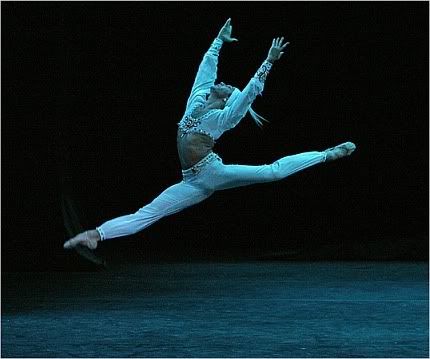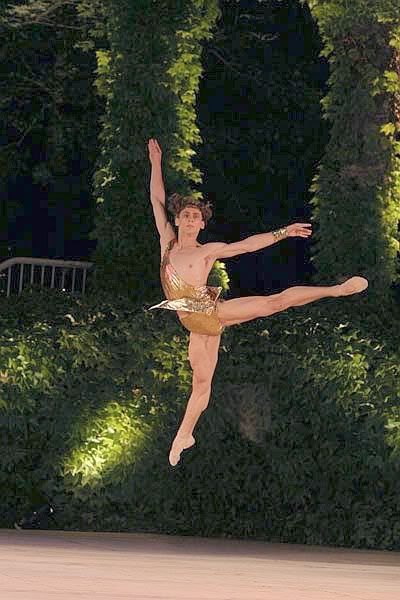El "Bolshoi" en Londres. "La Bayadera".
Dance Review 'La Bayadère' |
| The Bolshoi's Whiz Kids on Display in London By ALASTAIR MACAULAY Published: August 6, 2007 |
|
|
| LONDON, Aug. 4 — The Bolshoi Ballet's latest whiz kid, Ivan Vasiliev, is a colorful, engaging, 18-year-old firecracker who looks good as a smiling, fully clad and mustachioed slave in a virtuoso divertissement pas de deux in Act 1 of "Le Corsaire" or as a stone-faced, near-naked, painted-gold-all-over dancing statue in Act 2 of "La Bayadère." Hype before the Bolshoi's three-week season at the Coliseum here was wrong to exaggerate his potential by portraying him as another Baryshnikov. His jumps aren't actually of superhuman height, his landings are sometimes audible and (like other Bolshoi men during the company's first London week) his enthusiasm for ending solos with a particularly flamboyant effect sometimes leads him to fall over. But it is evident that he's a star, and it is likely that he has not yet shown London all he can do. (He is said to be a particularly dazzling turner.) My abiding memory of him is from his "Corsaire" solo, when he performed a zigzag with the same short but thrilling phrase on each diagonal — claiming the air in a hungry assemblé jump, landing with a pounce into a deep grand plié (knees fully bent apart), and at once exploding into a forward sissonne jump, legs split as he hung in the air, and all with an eager naughtiness in his eye. The contrasts — up-down-up, out-in-out — are maximized, and he relishes them. It's easy to imagine that he is an actor, an artist. One wants him, first, to inherit the great 20th-century roles that were made in the West on Nijinsky, Edward Villella, Helgi Tomasson, Mikhail Baryshnikov, and then to inspire new roles. Both of which might happen. In Moscow, the Bolshoi now dances a fast-expanding collection of 20th-century Western ballets, from choreographers ranging from Massine and Balanchine to Twyla Tharp. And the company is run by Alexei Ratmansky, who is as bright a hope as any today to bring new choreographic life to ballet. But how much of these new developments will the West get to see? When the Bolshoi visited during the Soviet era, Western critics could condescend charmingly to the terrible limitations of its repertory, mainly a mix of standard 19th-century works and homemade but dance-thin 20th-century story ballets. Today, however, you'd have to go to Moscow to see the real range of the company's repertory. In its Western appearances, the need for box-office income means that it mainly relies on the same kind of story ballets as before. Mr. Ratmansky is varying the selection of 19th-century ballets, and has made a hit with his staging of Shostakovich's full-length "Bright Stream" (seen in New York in 2005, in London in 2006 and again scheduled at the end of this London season). It is already possible to feel that a new kind of Bolshoi is emerging under his aegis, a Bolshoi less colossal in scale but with a much greater appetite for detail in both acting and dancing. |
|
|
| But it's also possible, amid these good signs, to overlook the bad ones. Nobody is likely to recall this season's second offering as its highlight. This was the classic "La Bayadère," as staged in 1991 by Yuri Grigorovich (Mr. Ratmansky's long-term predecessor). Until 1978, when the Kirov's full-length production of "La Bayadère" was first shown on Western television, few people had much clue what this 1877 story ballet, set in India, was like. For the last several years, as full-length "Bayadères" have become staples of international repertory, I've begun to feel that ignorance was bliss. The Bolshoi's version features, among other horrors, white children dressed as blacks (black-wrinkled tights, black-gloved sleeves and black curly wigs, but with faces lightly daubed in various pale coffee hues). I'd like to think that the old tradition of whites in blackface might work again if it was well done (e.g. white actors as Othello, now exceptionally rare in theater), but this looked too ludicrous to be even grotesque. Almost as irksome was the costume for the second-cast hero, Denis Matvienko. Since he is pale and blond, the company's idea of presenting him as an Indian warrior is to put him in lilac-colored pajamas with a plunging neckline on top of a tan-flesh-colored undervest. By contrast, the first-cast hero, Nikolai Tsiskaridze, who has darkish skin anyway, danced with an extensively bare midriff, his lilac trousers matched by a jeweled short-sleeved bikini top. One might put up with much if only the "Shades" scene was transcendent in any way: transcendence is what that's all about. The Bolshoi's had impressive features: a corps de ballet of 32 women doing the famous single-file entrance with legs in arabesque, all rising unusually high. But throughout the corps, there were different ideas about where the front arm should go, where the eyes should be directed and how the back should work. The scene became a technical feat without any serious classical poetry. |
|
|
| The main event of the first cast was the confirmation, as in "Le Corsaire," that the Bolshoi's beautiful prima Svetlana Zakharova is waking up as an artist of nuance and authority. Even so, she's at her least nuanced where she needs to be most, in the "Shades" scene. The same problem applies to the dignified, intelligent second-cast Svetlana Lunkina. Another junior whiz kid, Natalia Osipova, played the second heroine, Gamzatti. She has a prodigiously high jump and is mistress of all the arduous technical hurdles of the role. But her acting consists of making Gamzatti a coldly triumphant bitch, and her dancing tends to emphasize flash, often at the cost of shortening her phrases and giving her energy an impacted, ungenerous quality. "Ungenerous" is a word that is seldom applied to Bolshoi performers, and it didn't apply to Ms. Osipova last year in Mr. Ratmansky's "Jeu de Cartes." We are watching the Bolshoi in a state of change, but there is no predicting just what direction the change will take this sometimes most life-enhancing of ballet companies. Related |




0 Comments:
Post a Comment
Subscribe to Post Comments [Atom]
<< Home